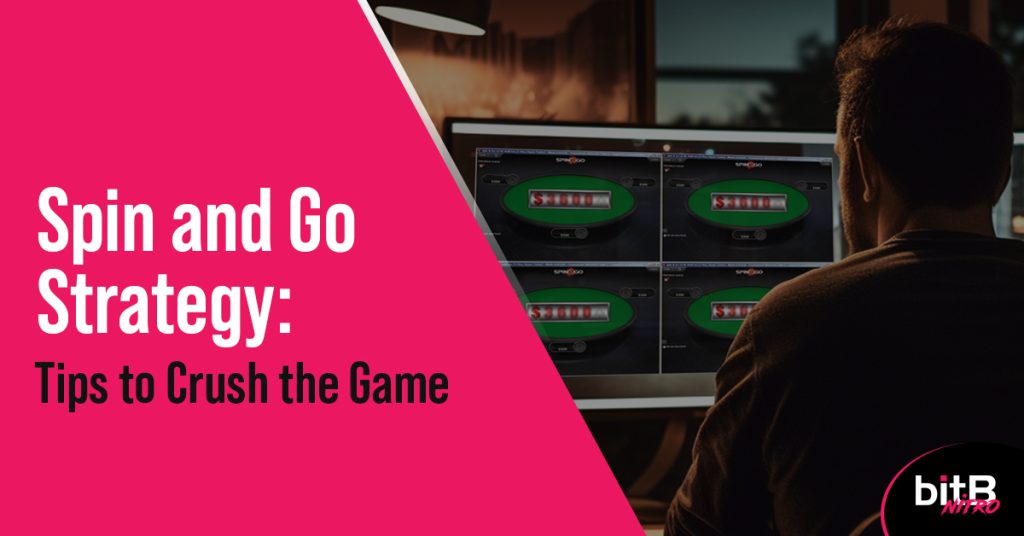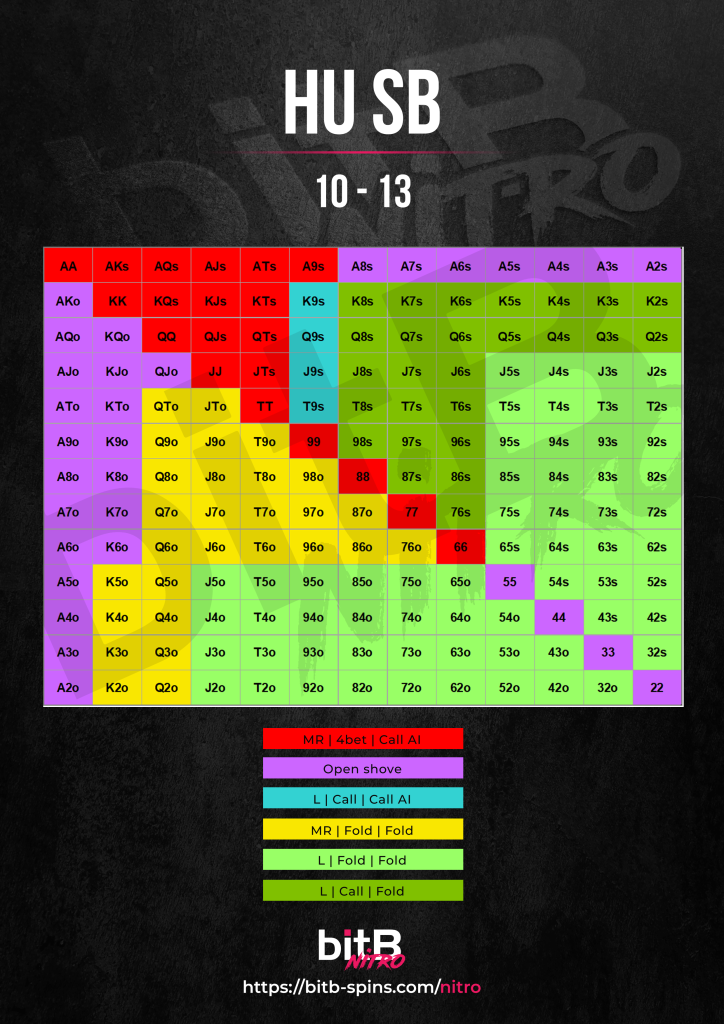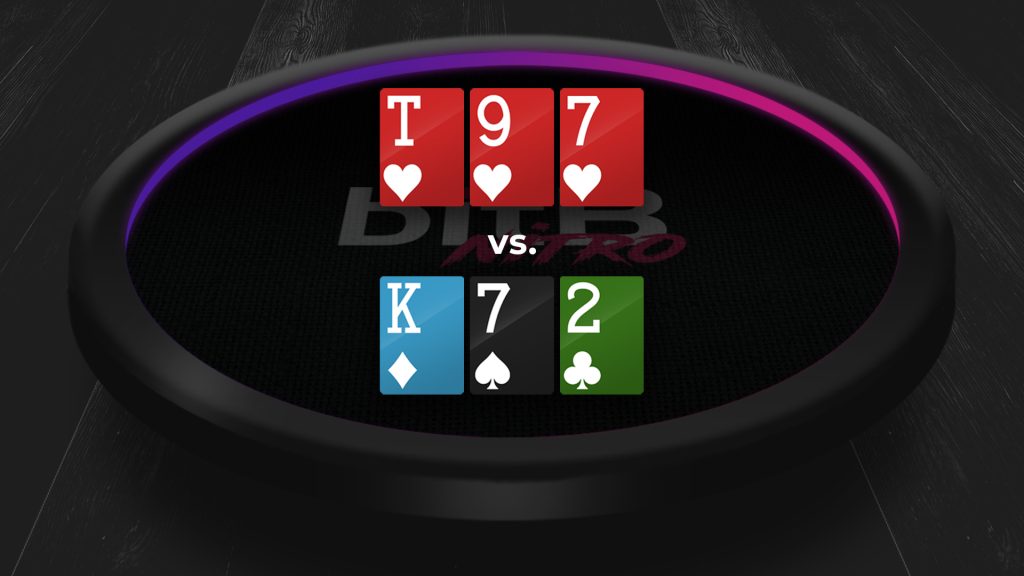Spin and Go Strategy: Tips to Crush the Game
SPIN AND GO STRATEGY: PREFLOP
Let me start with a provocative statement: most money in Spin and Go games is made with an exploitative strategy, not with a perfectly balanced one.
This is especially true for low- and mid-stakes games, where both recreational players and even regulars have plenty of leaks in their game.
To explain why, I would first like to offer you a helpful analogy and then demonstrate the same principle with a few concrete, practical poker examples.
So, the analogy: imagine you are playing a simple game of ‘rock, paper, scissors’ with a friend. For the first 10 minutes, both of you aim to perfectly randomize your choices, with neither managing to come ahead strategically.
Then, your friend gets lazy and starts mostly showing “rock,” with the occasional ‘paper’ and rarely ‘scissors.’ I’m sure you’ve already devised a plan to win: you’ll need to mostly show ‘paper’ and maybe occasionally mix in some “rock” and “scissors” to be less blatant about it. Easy enough, right?
Now, the mind-blowing part: consider the outcome of your previous seemingly perfect randomized strategy if you fail to observe and adjust.
Let’s simplify it further for clarity: imagine your friend only ever shows ‘rock’ while you play a perfectly balanced mix. You would win 33.3% of the time with ‘paper,’ tie 33.3% with your own ‘rock,’ and lose 33.3% with ‘scissors.’
From this, an important insight follows: while a perfectly balanced strategy is best against another perfectly balanced strategy, it is no longer optimal against any strategy that is not “perfect.” It also fails to capture any extra EV from your opponent’s mistakes.
So, that’s all well and good, but how do you use it in your actual game?
Consider what sort of mistakes players tend to make most often:
- not playing enough hands
- not defending wide enough
- being too passive overall
Let’s consider the HUSB preflop strategy. It is not unreasonable to expect that almost anyone on low stakes would:
- fold versus MR a bit too much
- wouldn’t 3bet enough
- wouldn’t be quick to spot and properly understand if we were to play an exploitative strategy
It is precisely for those reasons that you can still MR against hobby players even down to 10bb:
HU SB Chart from the 30-day commitment-free trial program
In fact, if you play against somebody who folds vs. MR a lot (let’s say, more than 35-40%), you can consider minraising even more hands than that, potentially including even the worst offsuited hands.
However, the full reason why we might want to MR more hands doesn’t end with preflop considerations; to fully understand it, we’d also need to evaluate postflop factors.
SPIN AND GO STRATEGY: POSTFLOP
Let’s review the preflop assumptions: recreational players might be too quick to fold some of their hands and could be expected not to apply as much pressure as skilled pros would.
They might also be more transparent regarding the strength of their hole cards, giving us hints by leading in spots where they shouldn’t (though you shouldn’t automatically assume all such leads are strong either), or even by fastplaying their strong hands.
Think back to the analogy and try to form a hypothesis or two for how to exploit such behavior in the best way.
Let’s start with the obvious: if we expect recreational players to overfold, we should do more betting, simple as that. We would also reach the same conclusion by factoring in the occasional leads, which would weaken their checking range.
Similarly, we should give them more credit when they show a lot of strength (for example, when they triple-barrel against us).
A more nuanced approach would take this idea and then consider different board types: imagine T97 suited board versus a K72 rainbow board.
Even a beginner player would find a lot of hands to defend on a T97s flop: you’d have straights, two pairs, regular pairs, flush draws, open-enders, a near-endless pool of gutshots, and high equity hands with two overcards.
Frankly, almost all hands would get at least a small piece of the board! What would that mean for a pro? That a bottom pair with no additional equity, something like 74, wouldn’t be too good here, let alone those plentiful one-card gutshots.
Now, let’s take the K72 rainbow. This structure is so dry that even a pair of deuces is a reasonably strong hand, but it wouldn’t be enough to defend just pairs here. You’d need to consider the best high cards and less obvious draws like a better backdoor straight draw and backdoor flush draw (you’d typically see these written as BDSD and BDFD).
Which of those two boards is more likely to cause a recreational player to mess up and underdefend? Right, the latter. How would that impact your own cbetting strategy in the HUSB? You’d want to cbet a lot on dry boards and be much more cautious on wet boards.
You can apply similar principles to later streets, the turn, the river, and 3-way pots. On a more advanced level, you would also want to consider ranges (both your own and your opponent’s), game flow dynamics, and villain’s exact profiles.
The list of essential exploits obviously doesn’t end there, but all of them stem from the same principle: think about which way you expect your opponent to deviate from balance, then think about how to best take advantage of that.
SPIN AND GO COACHING
When it comes to Spin and Go coaching, you can either go solo or join a backing / staking team. Let’s take a look at both options.
Learning spin and go alone:
- A great first step is to get reliable charts to help with your preflop game. Our 30-day commitment-free trial period includes charts covering every possible preflop scenario
- HUD software can further elevate your game after you are familiar with the game and the stake you play on. Hand2Note is a fantastic, free option.
- Study groups or even a friend to study with and discuss hands have immense value and can accelerate your learning. Finding these opportunities is not necessarily easy, though.
- Watching Spin and Go YouTube videos or streams can also help.
- Free communities can also help a lot to orient yourself in the world of spin games. If you have any questions, hop on our Public Discord server and ask away!
If you decide to join bitB Spins:
- You’ll go through a full onboarding process, including setting up your HUD and gaining access to all the crucial videos to watch.
- You can familiarize yourself with our core strategy, and our coaches will pinpoint areas you’ll need to work on and recommend videos to help you better understand certain concepts.
- You’ll be able to acquire a decent sample in a safe environment and use it with our special Leakfinder HUD tool to evaluate your game and receive personalized recommendations.
- There are always weekly coaching sessions to attend based on your current skill level.
- Since we have a lot of dedicated players, it’s fairly easy to find someone to study with. Also, in our dedicated hand channels you are welcome to post any of your questionable hands and get answers from coaches and other players.
- As your Spin and Go skills grow, besides moving to higher stakes, you will gain access to new, nuanced materials.
SPIN AND GO BANKROLL MANAGEMENT
Bankroll management for Spin and Gos is just as important as the strategy itself. Neglecting it is a surefire way to go broke. However, having a solid understanding of it for your specific type of game can help you manage downswings by dictating which stake you should play on.
While your skill determines your long-term success, luck—and therefore variance—plays a significant role in poker. This is especially true in Spin and Go games, particularly in the flash format. Good bankroll management should save you a lot of headaches and unnecessary stress.
There’s no one-size-fits-all solution; it depends on your own needs. How much risk are you willing to take? Are you okay with moving up and down frequently, or do you prefer to move slowly? Do you tend to tilt and stop following your own BRM? These are all questions you have to answer honestly to find the system that works for you.
Here’s a good starting point for Spin and Go Flash games, based on your preference :
*The risk percentage of moving down depends on your cEV and RB.
At the end of the day, you won’t be able to control your results fully, so you must be comfortable with the BRM you choose. It can ensure that you don’t lose all of your money. Granted, it can only do so if you are somewhat decent at the game and stake you play.
Just remember: moving down in stakes is not a defeat but a part of playing poker.
CONCLUSION
Throughout the article, you’ll find countless tips to improve your game. Please stop by our Discord server if you have any questions. And if you’re looking to take your game to the next level, consider applying to bitB Spins! 🙂




